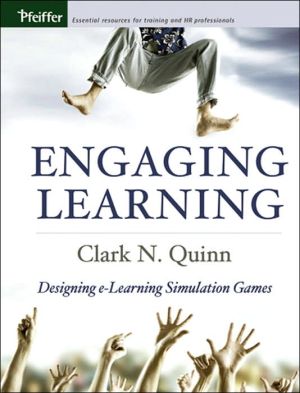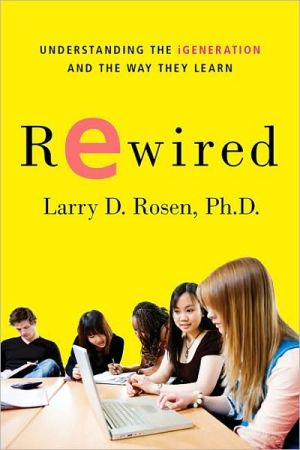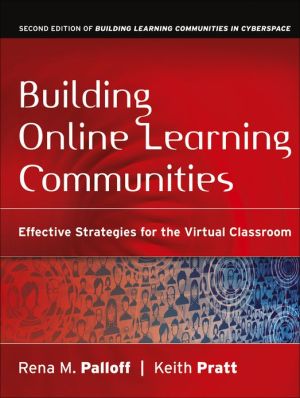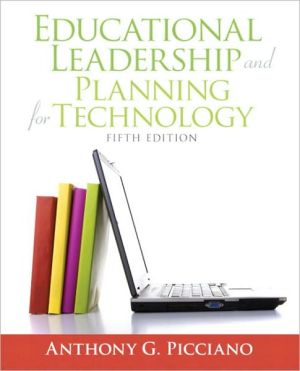Engaging Learning: Designing e-Learning Simulation Games
Learning Can and Should Be Hard Fun!\ "I believe you will find that the book you are holding is equally useful for the curious learner as for the e-learning developer interested in creating something truly special. It explains beautifully and gently not only how to craft more meaningful learning experiences, but also why it is vital to do so. I look forward to seeing what you create as a result of what you learn here. You have the opportunity to truly change the world."\ —From the Foreword by...
Search in google:
Learning is at its best when it is goal-oriented, contextual, interesting, challenging, and interactive. These same winning characteristics also define the best computer games, which suggests that the most effective learning experiences are also engaging. Learning can and should be hard fun! The challenge is to get in touch with what it takes to design learning experiences that will excite your audience. Engaging Learning offers a much-needed guide for training professionals who want to create learning programs that are both effective and engaging. Clark N. Quinn, a learning system designer, presents a unique framework for systematically aligning the key elements of learning and engagement with a proven design process for e-learning games. This nuts-and-bolts guide, which is both research-based and grounded in experience, offers the tools needed to transform learning experiences from humdrum to fun.Engaging Learning is the hands-on guide to designing learning programs and specifically simulation games that engage and educate—the type of learning we need. Illustrated with case studies, the book shows trainers and instructional designers what they have to know to create e-learning games and suggests how to do it on a budget and on a schedule. Engaging Learning also shows why this process can improve completion rates and garner rave reviews from learners. Using this revolutionary process, even the most inexperienced trainers or instructional designers can feel confident tackling the design of their own simulation or learning game. This bookIntroduces an enhanced instructional design modelOutlines the criteria for creating meaningful learning experiencesExplains the common principles that define compelling learning experiencesExplores the different levels of games and learning from mini-scenarios, through linked and contingent scenarios, to a full engine-driven experience Defines a new design process for simulations and e-learningDiscusses the use of media, pragmatics of production, and budgetary concerns accommodating various audiencesEngaging Learning will give you permission to stay abreast of what people say about learning. At conferences, look for talks about using dramatic presentations, keeping learners motivated, and the value of making learners laugh. Read books, trade magazines, and journal articles—whatever you can find. Similarly, see what's being said about having fun. And, of course, have fun yourself. As mentioned before, you now have license to read novels, watch movies, and play games.
Engaging Learning\ \ By Clark N. Quinn \ John Wiley & Sons\ ISBN: 0-7879-7522-2 \ \ \ Chapter One\ Games? Really?\ IN 1982, John Carroll noticed people playing what was probably the first computer adventure game, "Colossal Cave." He observed then what we see now, people hunched over a computer spending hours figuring out how to get further in the game. He compared that observation to people who were giving up on something considerably more valuable to them, learning to use a word processor.\ At that time, I had a job creating educational computer games for the Apple II and other, similar, machines. It was my first job out of college, and I'd already been bitten by the computers-and-learning bug badly enough that I'd designed my own major in it (back then, they didn't have such degrees). And, as a professional obligation mind you, I was playing computer games, including the "Colossal Cave" adventure. I was captured by the possibility of embedding important decisions in adventure games and creating learning environments.\ And that is really what this book is about, the results of a twenty-plus-year journey from that point, driven by a belief that learning can be fun. My understanding has been refined through research and trial-by-fire, and also buttressed with evidence. I heard the phrase "hard fun," and realized that is what I mean. It's fun, in the sense that you're engaged, there is a story that you care about, and you have the power to act; it's hard in that it's not trivial-thereis sufficient challenge to keep you on your toes. And I most emphatically do not want you to infer that I mean the types of games where we put drill and kill, er, drill and practice, into game-based window dressing. I mean something more profound, more important, and more useful. But that is all to come.\ To start, my plea is for you to stop doing e-learning the old way. That is, rewriting PowerPoint files and PDFs into online text (whether "gussied up" with graphics, photos, videos, or not) and multiple-choice knowledge tests (whether jazzed up with drag-and-drop or not). Or putting narrated slide presentations up on the Web. Yes, you can do that, and sometimes you have to (because of cost or time pressures). But stop first, and consider the alternatives. Understand that making things interesting can make them more effective, if you know how (and can interfere with learning if you don't), and that there are low roads that give you a lot of benefit for low investment as well as the high road. Then you can make an informed choice.\ We are not, cannot be, about designing content. A fundamental perspective I want you to take away is that we are designing experiences. If nothing else, start thinking not about creating content but about designing learner environments and architecting experiences. It has become clear to me that this is a fundamental point. You have to start thinking about putting the learners into a context where they have to make decisions, understand why those decisions are important, want to make those decisions, and know that there are consequences of those decisions.\ If you don't, you're likely to be dooming your audience to ineffective and, really, user-abusive learning. You don't have to make boring e-learning. Yet that is what I see, reliably and repeatedly. And it's not just me, the evidence is pretty consistent: when it comes to online learning, content people are staying away in droves. That has been the message from the analysts, the users, and the marketplace.\ Of course, we'd like to develop richly engaging games that address key learning outcomes and are wildly fun, but even if we had the budget, would we know how? Or can we develop engaging learning on the average shoestring budget? I'll argue yes, absolutely, to both (and there are ways to boost that budget).\ It is not because the content developers are not trying; it is because the elements of engagement are not understood. And it's not just a matter of putting entertainment and education folks in a room and locking the door. You have to understand the elements of both and find the alignment.\ Let me put a stake in the ground here. It is hard to do good education. That is why people spend years learning how to do it. Even then, not all do more than follow the prescriptions and keep a finger on the pulse of the industry to improve their practice. It is also hard to do good entertainment. For every movie in Hollywood that is a hit, there are four or five that don't succeed. The same is true in the game industry (though I understand the ratios are even worse). It is doubly hard to do both together. Coordinating the elements requires a balancing act between the two, which can be well nigh impossible if you don't know how they work together (many assume that education and engagement are irreconcilable). Yet it is more than doubly worthwhile.\ If you look at the elements that lead to learning, and put them in correspondence with the elements that lead to engagement, you'll see that they can be aligned and become mutually synergistic. By using that framework as guidance, you can systematically design learning that is both more effective and engaging. That is the thesis of this book.\ Learning can, and should, be hard fun.\ Engaging Experiences\ At its best, learning is a wildly enjoyable experience. There are joyous discoveries, satisfied completions, and sudden recognitions. Think of children in that magic time of childhood before school undermines their intrinsic curiosity. All of us have interests about which we learn for no other reward than our own personal satisfaction. Whether it is a team sport such as baseball or an individual activity like fishing, a hobby such as collecting or crafts, or a personal pursuit such as philosophy or politics, in the pursuit of this informal learning we may be remarkably persistent in the face of adversity. We will learn by reading, by talking with people, perhaps by Web searching, buying books, watching specials, or joining societies.\ However, this isn't what most people think of when they think of learning, particularly when it is codified as education or training. You're likely to get somewhat different responses: "I haven't time"; "Let me just read a book"; or "Not more school!" Drop-out rates for online learning have been listed as high as 80 percent. A renowned business school theorist suggests that what motivates people to take training is fear of being unable to perform, rather than any intrinsic value.\ If you think that learning has to be "read this and take the test," then you haven't been paying attention to what's known about how we learn. The evidence is that learning is more effective if it attracts the attention and interest of the learner, is obviously relevant, requires action on the part of the learner, and is contextualized so that the learner understands how and when to apply it. In short, we need to address the emotional side of the learning as well as the knowledge side.\ What we want is learning that engages the learner, but what we have is learning that bores or confuses the learner. Here, engagement is the word used to describe the situation when learners are captured, heart and mind, in learning-or to use formal terms, are cognitively and affectively connected to the learning experience. The best learning experiences generally available are either high-fidelity simulations or interactive sessions with skilled facilitators. However, most learning experiences involve heavy use of text, too many knowledge-test assessments, and facilitators who might care but are not so skilled as is needed.\ Let me be clear, I'm not talking about game shows or gussied-up drill and practice. I am not advocating putting lipstick on the pig of fact-based learning. Instead, I am talking about the type of learning environment where you have a challenging goal set in a believable theme, and you must struggle to achieve the goal. We should be creating a learning environment where we transform our learning objectives to important behaviors, where contexts are meaningful to the learner, and where the decisions are consequential. These are the learning experiences that will make a difference, and they are what we should be shooting for.\ Let me also acknowledge that I do not believe that these engaging learning experiences will (or should be expected to), by themselves, lead to learning. I advocate discussion around the experience, and connecting learner actions to the underlying concept. As yet, computers are not quite capable of supporting such dialogue. Self-directed learners may be capable of facilitating their own reflection, but it's not the way to bet (though I believe strongly that meta-learning, or learning to learn, is a key leverage point for the future). So although such environments are not sufficient, they are necessary; we need engaging experiences to motivate learners to attend to the content, give them rich practice opportunities, and provide fodder for discussion and refinement of their understanding.\ Why Engagement?\ Why should learning be hard fun? Surely, learners should buckle down and do what they need to do to acquire the necessary skills. Perhaps in an ideal world learners would be motivated and self-directed. We know, however, that having the pull of a challenging learning experience is still an advantage.\ As long as engagement doesn't hurt, it's a positive. It doesn't have to help; as long as it doesn't interfere it can be argued to be valuable (of course, if the cost isn't too high). For instance, the Masie Center found that 70 percent of survey respondents would be very interested in a learning process that has computer games. I'll bet most folks developing learning would be thrilled to have 70 percent of their audience heading into the learning experience very interested.\ People intuitively think that learning through games ought to be better, but is there any evidence? Although I won't be academic throughout (though there will be times), let me briefly review some findings. Work on cognitive science, education, anthropology, and practical experience guide the view that engagement enhances learning (when done right).\ Some cognitive research either directly demonstrates or indirectly suggests the value of adding engagement to learning. Mark Lepper of Stanford University has investigated motivation in learning and in a key experiment showed that adding story enhancements to mathematics instruction improved outcomes (Lepper & Cordova, 1992). We can also use some inferences from the work of Phil Johnson-Laird of the Psychology Unit in Cambridge, who found that complex decisions are made more tractable by the addition of concrete context (e.g., Johnson-Laird, Legrenzi, & Legrenzi, 1972), which is part of the engagement process. Jean Lave at the University of California at Berkeley (1988) cites work on Brazilian street kids who can't seem to be taught mathematics, yet are actually quite good at doing calculation in the monetary tasks they perform to survive (showing motivational effects on learning).\ We also see significant evidence in learning theory. The anchored instruction approach of John Bransford and his colleagues at Vanderbilt (Cognition and Technology Group, 1990) has had success in teaching a variety of core curricula such as mathematics through rich media and story. Jeroen Van Merrienboer's (1997) work on teaching complex skills suggests that we need full practice in simulated environments. Roger Schank's work on goal-based scenarios indicates the need for a goal and an exploratory environment to drive learning (Schank & Cleary, 1995). The entire focus of Howard Barrows's problem-based learning (Barrows, 1986), and case studies such as Harvard Business School's pedagogy, is to help make the learning more concrete and meaningful.\ There's more pragmatic evidence as well. The military has a significant investment in rich simulations as training tools. Institutes continue to be founded to investigate games and training or learning. The Massachusetts Institute of Technology has one of the newest, and the University of Southern California has one as well. A surfeit of new books also talk about the need for games or simulations as learning environments: Marc Prensky, Clark Aldrich, James Gee, the list goes on. By the way, I'll differentiate between games and simulations (and approximations thereto) later on, but briefly, simulations rely on underlying models, not prescripted branches, and games are simulations with the aesthetic tuned to create an optimal level of engagement.\ Finally, as Donald Norman's book Emotional Design points out, the effect of the experience adds to our ability to think and perform. As we begin to explore how emotional experience affects our cognition, the picture increasingly shows that the aesthetics matter. If this is indeed the case, we need to exploit this opportunity to our advantage. We can design learning experiences that have positive effect and have reasons to believe that is more effective for learning.\ Games for learning are not just a guilty pleasure! The evidence is clear that rich environments and story lines are more engaging and more effective. But the real reason to investigate this comes from the second half of that claim. We need more effective learning. Why?\ The Learning-Doing Continuum\ Our goal is not to help people learn. That's a tactic. If we said people need to learn X and then made sure that happened, we wouldn't be doing our job. In organizations, the direction is no longer to hypothesize needs but to justify the cost. And the industry has moved beyond return-on-investment arguments. It's not about showing that improvement happens as an outcome of the training. Or even counting the dollar benefits of the outcomes. Instead, the goal now for training is to target and improve the key performance indicators of the organization. This trend is currently also reflected in the metrics associated with schools, though I hope that schools will soon move to a more realistic way of assessment that targets what learners actually can do (for example, portfolios of work) and not just what they know.\ No, the goal is clear: we must help people do. And that, at the end of the day, is the strongest argument for focusing on engagement in learning, because learning designed to incorporate engagement is more effective.\ So why is our learning so dry? A widely cited Forrester report (Hogg, 2002) found that 75 percent of e-learners do not finish their courses. This is not because the courses are engaging learning experiences. We're following the prescriptions of instructional design, which we know is empirically based to ensure learning outcomes. What is new are the results of cognitive research (mentioned above) that suggest extensions to our learning design. This research begins to give us ideas of what we need in an environment. What hasn't been presented to date is a reliable way to get there.\ A learning environment has to be designed properly to incorporate engagement that integrates with effectiveness. The problem is figuring out how to do it, particularly under real-world constraints, and seeing whether there are intermediate steps that can give us leverage when we simply can't justify the development of a full game engine. Just putting educational people and entertainment people in the same room isn't going to do it, because they don't have a shared vocabulary or any understanding of how their work aligns and synergizes. That there have been more failures than successes is not a surprise. Yet if we do understand both sides, we can make them work together to accomplish this goal of better learning experience and better learning.\ Is this approach appropriate for all learning objectives? Yes and no. If your learning objectives are about knowledge-for example, does someone know x or y-you don't need to create engaging scenarios (though you can ramp up the engagement with quiz show-type trappings). However, I believe we mistakenly think that knowledge alone will solve our problem, when usually we need that knowledge to be actionable-and then we do need an engaged approach. Sometimes you will want to have lower-level knowledge automated, so that you're equipped to take on more complex decisions, but I believe in putting the decisions first to motivate learners to recognize why they need the more-rote practice. Then you can make that more enjoyable, too, but the focus has to be on the ability to do. And that requires focus on creating a learning experience.\ (Continues...)\ \ \ \ \ Excerpted from Engaging Learning by Clark N. Quinn Excerpted by permission.\ All rights reserved. No part of this excerpt may be reproduced or reprinted without permission in writing from the publisher.\ Excerpts are provided by Dial-A-Book Inc. solely for the personal use of visitors to this web site. \ \
Pt. ASetting the stageCh. 1Games? : really?9Ch. 2Learning basics23Ch. 3Experience basics39Pt. BA play in three actsCh. 4Engagement-education synergy53Ch. 5Trajectory75Ch. 6A design process113Pt. CSet design and afterthoughtsCh. 7Pragmatics157Ch. 8Future issues179Ch. 9Conclusion187








